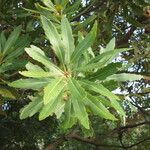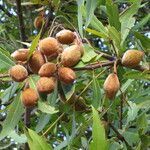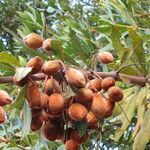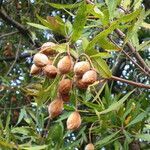An evergreen tree or shrub. It grows to 7.5 m tall. It has a thick greyish brown bark. It has spreading branches. The leaves are long and sword shaped. They are 15 cm long by 2.5 cm wide. They are arranged in rings of six leaves. The leaves have irregular teeth along the edge and a prominent midrib. The young leaves are soft and golden. The flowers are white and hairy. They have a sweet scent. They occur in dense clusters in the axils of leaves. The fruit is 2-4 cm across and one seeded. The seed is enclosed in a golden velvety coat.
Widely spreading tree to 8 m. Leaves in whorls of (4-)6(-9), oblanceolate, toothed. Flowers in dense racemes, white. Fruits almond-shaped, velvety.





